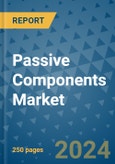Global passive components market continues its upward trajectory, with sales projected to surge at a Compound Annual Growth Rate (CAGR) of 6.0% from 2024 to 2031. A recent study reveals that the market size reached US$ 16 billion in 2024, and is poised to surpass a valuation of US$ 24 billion by the end of 2031.
This product will be delivered within 1-3 business days.
Capacitors: The Powerhouse of Revenue Generation
Capacitors are anticipated to maintain their position as the top revenue-generating product category, with a robust CAGR of over 5.7% during the forecast period. The burgeoning demand across various industries such as consumer electronics, automotive, industrial machinery, solar energy, and medical devices is driving the growth of the passive components industry.Driving Forces Behind Increased Demand
The demand for passive components is being fueled by the rapid digitalization and the consequent surge in the adoption of consumer electronic devices worldwide. The production and sales of medical devices, solar panels, industrial machines, and the expansion of the automotive industry, especially the rise of electric and autonomous vehicles, are also significant factors contributing to the growing demand for passive components.Region-wise Growth Potential
Asia Pacific emerges as the most dominant market for passive components, with a valuation of US$ 8.2 billion in 2024. The region is estimated to witness substantial growth, with the market size expected to increase to US$ 11.20 billion by 2031. Rapid growth in the consumer electronics and automotive sectors in countries like China, India, and Japan is a major driving force behind the demand for passive components in the Asia Pacific market.United States: A Steady Surge in Demand
The United States is forecasted to witness significant growth in the passive components market, with sales reaching US$ 3.90 billion by 2031. Factors such as the rapid expansion of the IT and communication industry, increasing investments in solar projects, and rising exports of electronic products are driving the demand in the US market.United Kingdom: Riding the Wave of Consumer Electronics
The United Kingdom market is set to exhibit a steady growth trajectory, with a CAGR of 4.3% during the projection period. The burgeoning sales of consumer electronics are propelling the demand for passive components in the UK market, as these components have become indispensable in various electronic devices.China: A Lucrative Hub for Passive Components
China emerges as the most lucrative market worldwide, with a projected valuation of US$ 5.4 billion by 2031. The robust growth of the automotive and consumer electronics industries, coupled with the heavy presence of leading manufacturers, contributes to the thriving passive components market in China.Japan: Driving Growth Through Innovation
Japan's passive components industry is expected to rise at a CAGR of 6.1% between 2024 and 2031, driven by the rising production and sales of electric vehicles and the growing adoption of consumer electronics. The presence of prominent passive component manufacturing companies further bolsters market expansion in Japan.Product Insights: Capacitors Leading the Pack
Among passive components, capacitors emerge as the top-selling product category, with a steady CAGR of 5.7% during the forecast period. The increasing usage of capacitors in various applications such as energy storage, power conditioning, and sensors is driving the expansion of the passive components industry.End User Analysis: Automotive Sector Takes the Lead
The automotive sector is expected to remain the leading end user for passive components, with a CAGR of 5.6% between 2024 and 2031. The rising usage of passive components in automotive electronics, particularly in electric vehicles, is fueling the growth of this segment.Competitive Analysis: Key Players Driving Innovation
Leading passive component manufacturers are adopting various strategies such as new product launches, partnerships, and acquisitions to strengthen their presence in regional and domestic markets.Key Companies Profiled
- KEMET Corp.
- KYOCERA AVX Components Corp
- Murata Manufacturing Co. Ltd.
- NICHICON Corp
- Nippon Chemi Con Corp
- Panasonic Corp
- Ryosan Co
- Samsung Electro Mechanics Co. Ltd
- TAIYO YUDEN CO. LTD.
- Yageo Corp
Global Passive Components Industry Segmentation:
By Product:
- Capacitors
- Resistors
- Inductors
- Diode
- Transformers
By End User:
- IT and Telecommunication
- Consumer Electronics
- Automotive
- Industrial Machinery
- Others
By Region:
- North America
- Europe
- Asia Pacific
- Latin America
- Middle East & Africa
This product will be delivered within 1-3 business days.
Table of Contents
1. Executive Summary
2. Market Overview
3. Global Passive Components Market Outlook, 2018 - 2031
4. North America Passive Components Market Outlook, 2018 - 2031
5. Europe Passive Components Market Outlook, 2018 - 2031
6. Asia Pacific Passive Components Market Outlook, 2018 - 2031
7. Latin America Passive Components Market Outlook, 2018 - 2031
8. Middle East & Africa Passive Components Market Outlook, 2018 - 2031
9. Competitive Landscape
10. Appendix
Companies Mentioned
- KEMET Corp.
- KYOCERA AVX Components Corp
- Murata Manufacturing Co. Ltd.
- NICHICON Corp
- Nippon Chemi Con Corp
- Panasonic Corp
- Ryosan Co
- Samsung Electro Mechanics Co. Ltd
- TAIYO YUDEN CO. LTD.
- Yageo Corp
Methodology

LOADING...








